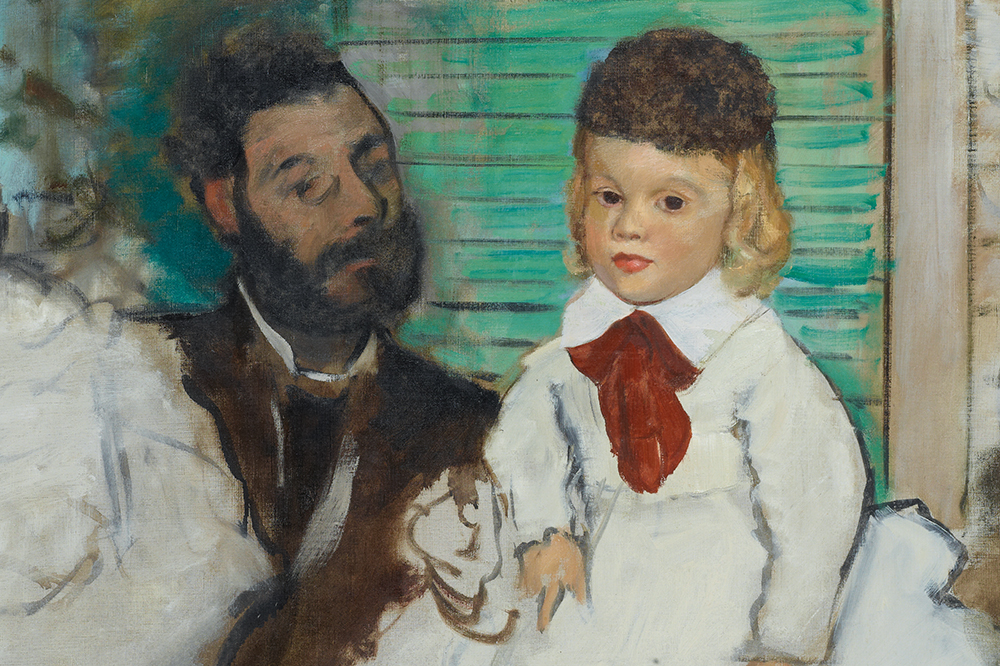From the April 2024 issue of Apollo. Preview and subscribe here.
After speaking about art and motherhood at a recent conference in Amsterdam, I was interviewed for a Dutch newspaper. As the journalist wound up he asked, almost apologetically, where the fathers were. Did any artist fathers make art about fatherhood, he wondered. If so, who?
Before the conference I had slipped into the Rijksmuseum to revisit the Frans Hals exhibition. Hals, that great master of fleeting expression, was a fantastic painter of children. Working on commission for clients, he delivered family portraits animated by spirited offspring – he had quite the line in imperious babies. For the open market he painted children at their most wayward and mischievous, including his own. It is unclear how many children Hals had; I imagine some did not survive to adulthood. The Rijksmuseum estimates three by his first wife (who left him a widower in 1615) and 11 by his second (who outlived him). Three small paintings in the exhibition are thought to be of Hals’s children – a laughing boy who is perhaps three years old, a girl singing, and a boy in a bearskin cap animatedly playing the violin.‘
How about Frans Hals?’ I suggested, and hastily listed half a dozen other artists who had painted their children – among them Augustus John, Pierre Bonnard and Lucian Freud.

It was an unsatisfactory answer. To paint one’s child is not the same as to make art about fatherhood. A child is a subject in his or her own right. Hals, apparently a doting father, was often in debt (so many mouths to feed!). His portraits of children were made to sell – the singing girl and fiddling boy are thought to be part of a larger series on the five senses. Still, a portrait can speak eloquently about the relationship between artist and sitter – seldom more so than when that relationship is parent and child. Augustus John’s paintings of his son Robin as a young boy romanticise the freedom and wildness of youth. Robin’s hair is worn long, his cheeks are rosy from outdoor activity, and he wears a loose bohemian smock that suggests timeless childhood innocence. To John the free-spirited bohemian, childhood was a period of enviable liberation. In the portraits Robin gazes back warily, resistant: a sober foil to his father’s exuberant excesses.
The middle-class home and family were important subjects for the Impressionists and Post-Impressionists. In 1874, Édouard Manet painted the Monet family in their garden at Argenteuil. Camille sits on the grass in radiant white with her son Jean sprawled beside her. Claude Monet stands behind to one side, flanked by a large watering can as he attends to his herbaceous border. The arrangement of the human family is echoed by a rooster, hen and chick strutting in the foreground. There is some sleight of hand here, however, since Monet was not hanging out with his family in the garden but standing at his own easel painting Manet at work.
To paint one’s family is to be both present and separate, at once in the domestic realm and an observer of it. The familial relationships that the artist fathers of Impressionism celebrate are overwhelmingly those between mother and children. An exception is Edgar Degas, who twice painted his friend the artist Ludovic Lepic with his two daughters. I saw the earlier of the two pictures in Zurich last year – painted in 1870, just before Lepic left to fight in the Franco-Prussian War. It is rough and sketchy. While Eylau, his older daughter, is a fully formed character, Lepic and the younger Jeanine remain ghostly impressions. It is, nevertheless, full of evident affection, with Lepic cuddled up close to both girls, and turning to smile at Eylau. It is a wonderful portrait of fatherhood, though painted by an artist who was not a father. (Lepic, in his own work, favoured dogs as a subject over children.)

Fatherhood has remained an unusual subject, though perhaps this is changing as fathers become more involved in the dayto-day care of their children. For a few years now, Larry Achiampong has involved his children in his work, and the themes he explores derive from his reflections on family more broadly. His pandemic-era film Wayfinder (2022) opened with a recording of his eightyear-old daughter Zael, framing the slow questing narrative as if it were something from a child’s storybook.
In A Pledge (2024), made for a solo show this spring at the Stanley Picker Gallery in Kingston upon Thames, Achiampong reflects on less visible forms of inheritance – the behavioural patterns, trauma and even mental illness that might be passed down from parent to child. In the first half of the film, narrated by his son Sinai Lee, we see Achiampong through the simplified, fragmented vision of a Game Boy camera – 1990s technology made for an earlier generation of computer gamers. From behind the wheel of his car, his mind travels through time as well as space, and he thinks back to his own father driving in Ghana, the limits of their relationship and the car as a place of connection between men and their sons. In the second half, Achiampong and his son are seen practising goju-ryu karate, each focused on and responding to the other – two bodies moving in concert. It is an affecting meditation on what it means to be – and to be denied – a father.

From the April 2024 issue of Apollo. Preview and subscribe here.



